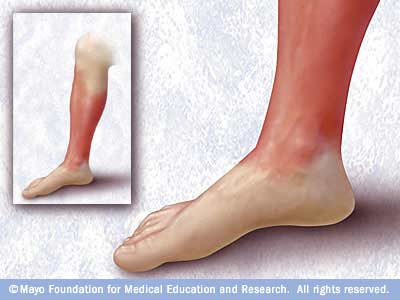Cellulitis - infection skin - what is, symptoms and treatment

What is Cellulitis and Definition
Cellulitis is INFLAMMATION of the inner layers of the SKIN and the underlying connective tissues, usually the result of a bacterial INFECTION. People who have PERIPHERAL VASCULAR DISEASE (PVD), DIABETES, or other health conditions that impair BLOOD circulation have increased risk for cellulitis. Cellulitis develops when a break in the skin, such as a cut or an insect bite or sting, allows BACTERIA normally present on the surface of the skin to enter and establish infection. The offending breach often comes from something so small as to appear insignificant until infection sets in. Staphylococcus is the most common type of bacteria responsible for cellulitis; Streptococcus is sometimes responsible. Bacteria also may enter via contamination of a penetrating object such as a splinter. Cellulitis requires prompt treatment with ANTIBIOTIC MEDICATIONS to minimize tissue damage and prevent the spread of infection.
Symptoms of Cellulitis and Diagnostic Path
Swelling, redness, and PAIN or itching are the key symptoms of cellulitis. The edges of the infection are diffuse, often making it difficult to establish a border between healthy and infected tissue. The doctor diagnoses cellulitis primarily on its appearance and symptoms. Usually no blood or other laboratory tests are necessary, unless the doctor suspects systemic infection (SEPTICEMIA) or questions the causative strain of bacteria.
Cellulitis Treatment Options and Outlook
For moderate, localized cellulitis the typical treatment is a course of oral antibiotics with close follow-up to make sure the selected antibiotic is effective against the infection and the cellulitis is improving. Warm, moist compresses over the infected area help draw blood the area, improving the body’s ability to fight the infection. When cellulitis affects a large area or multiple areas or worsens after antibiotic therapy begins, the doctor may place the person in the hospital for intravenous (IV) antibiotic therapy and continuous observation. Cellulitis in a person who is IMMUNOCOMPROMISED or otherwise debilitated requires especially aggressive treatment. Untreated or undertreated cellulitis can have serious consequences such as septicemia or GANGRENE (death of the tissue). Cellulitis also presents particular risk to people who have impaired circulation for any reason. With timely and appropriate treatment, most people recover fully.
Cellulitis Risk Factors and Preventive Measures
Wounds that break the skin breach the body’s first line of defense against infection. Prompt cleansing of the entry site with antibacterial soap and warm water, followed with topical antibiotic ointment and a bandage, helps reduce the amount of bacteria that enter the skin and limit their ability to cause infection. Early signs of infection, such as swelling, redness, or drainage, require prompt medical intervention that may include oral antibiotic medications. People who have diabetes, PVD, and other conditions that restrict peripheral circulation should develop the practice of regularly examining the feet, lower legs, fingers, hands, and lower arms for minor wounds that could become problematic as a measure for early identification and intervention to prevent cellulitis.
See also DECUBITUS ULCER; INSECT BITES AND STINGS; NECROTIZING FASCIITIS.